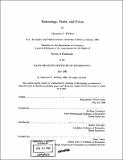Technology, trade, and prices
Author(s)
Wolfson, Alexander E. (Alexander Edward), 1973-
DownloadFull printable version (5.385Mb)
Other Contributors
Massachusetts Institute of Technology. Dept. of Economics.
Advisor
Rudiger Dornbusch and Daron Acemoglu.
Terms of use
Metadata
Show full item recordAbstract
This thesis considers the structure of international production and trade. Chapter 2 uses direct information on factor input requirements to consider which elements best explain the patterns of actual technologies. If there is factor price equalization, all countries will share the same capital-labor ratios, regardless of endowments. I find that actual technologies are inconsistent with this view. Estimates of country productivities which ignore the patterns of factor substitution are incorrect. Once allowances are made for differences in capitallabor endowments, 90% of the variation in output per worker can be explained by country-specific and industry-specific parameters. I also find that factor-augmenting productivities are negatively related to factor endowments. In Chapter 3, I consider the implications of these technological differences for measures of the factor content of trade. Typically, the factor content of trade is measured by applying one country's technology matrix to the output of all countries. Contrary to theory, this approach finds no relationship between factor endowments and the factor content of trade. Since countries use techniques which are biased towards their abundant factor, the factor content of trade flows in the correct direction when measured using actual technologies. However, the mystery of the missing trade remains: even when factor contents are measured correctly, they are a very small percentage of factor endowments. In Chapter 4, I use disaggregated price data from Canada and the United States to consider the propostion that the price of goods is equalized across countries. Using time-series cointegration methods, I find evidence in favour of the law of one price for some, mostly homogeneous traded goods. However, most goods, both traded and nontraded, provide little support for the law of one price. Moreover, deviations from the law of one price can persist for many years.
Description
Thesis (Ph.D.)--Massachusetts Institute of Technology, Dept. of Economics, c1999. Includes bibliographical references (p. 101-104).
Date issued
1999Department
Massachusetts Institute of Technology. Department of EconomicsPublisher
Massachusetts Institute of Technology
Keywords
Economics.